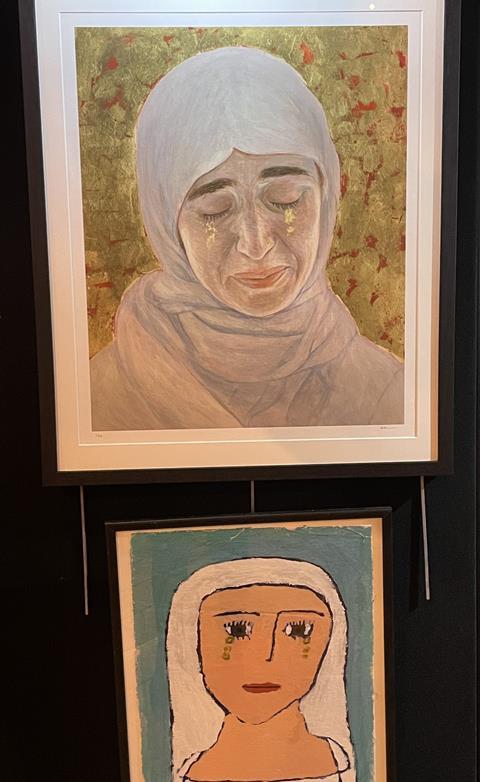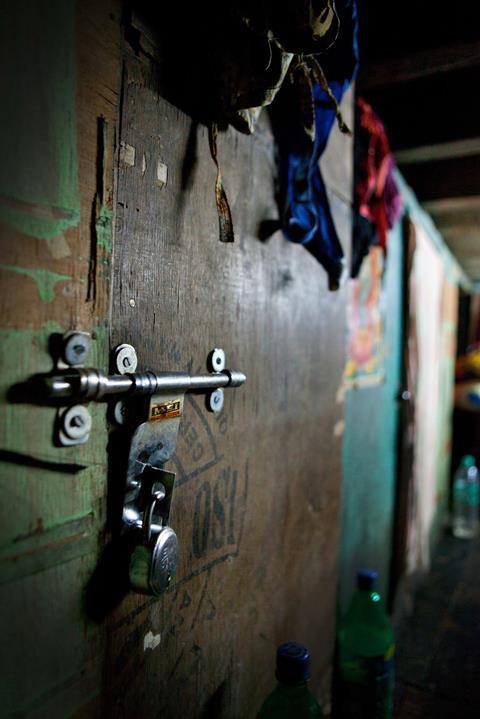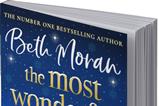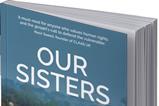Claire Musters listened to stories of women in Iraq, Kurdistan, Bangladesh and Nigeria through paintings and photography. ”We weren’t just hearing about these women, but seeing them too,” she said, and explains why that was so significant.

On International Women’s Day I had the privilege of attending the launch event for Tears of Gold, an incredible book reflecting a decade’s worth of work by artist and human rights activist Hannah Rose Thomas.
A whole day was given over to seminars from various charities working to end gender-based violence around the world, including Tearfund, Justice & Care, Sanctuary Foundation, Novi and Open Doors. Alongside these, the original artworks were on display throughout the day as well as a photography exhibition by award-winning photo journalist Hazel Thompson, who showed 20 years of her work highlighting modern-day slavery and exploitation of women in various places around the world – including the UK.
It was a sobering day listening to those giving the seminars sharing depressing facts about the values of cultures that so many women are born into.
In some countries it is still seen as a rite of passage to take a boy to a prostitute at the age of 12
For example, in some countries it is still seen as a rite of passage to take a boy to a prostitute at the age of 12. As Oddney Gumar from Novi commented, what does that do to his view of women as he grows into adulthood?
What was striking in every single seminar was that we moved beyond the horrifying statistics to listen to the stories of women who have faced brutality simply due to their gender.
Rape has become a weapon of war, and yet this reality is far removed from the everyday lives of many of us in living in the UK so it was a stark reminder of what is going on in our world today. It was heartbreaking listening to the stories of women who have been rejected by their husbands due to the shame of them having been raped and others who watched helplessly as their young daughters were taken from them.

A photo that Hazel Thompson shared will forever be etched in my mind: a wooden box that was one of many in which young girls were locked up in the eaves of a brothel – left in the pitch black, apart from during the times that men wanted to use them.
Teaching the women to paint their own self-portraits as a way to reclaim their personhood and self-worth, she also helped provide a safe space for them to tell their stories.
In the evening, we heard from Hannah about how her book came about. She met women in Iraqi Kurdistan, Bangladeshi refugee camps and northern Nigeria while organising art-based trauma therapy projects alongside a clinical psychologist. Teaching the women to paint their own self-portraits as a way to reclaim their personhood and self-worth, she also helped provide a safe space for them to tell their stories if they wanted to. On the second day of the project with Yazidi women, one of them (Layla) approached Hannah and asked her whether she would paint their portraits herself. Hannah commented: “It touched my heart that they would trust me with their stories in that way.” That is how Hannah began painting the portraits of Yazidi, Rohingya and Nigerian women.
Hannah explained that she incorporated early Renaissance painting techniques used in icon painting – gold leaf and lapis lazuli for the blue (often used for painting the Madonna) – in order to convey the women’s sacred value. She spoke of the power of the arts in helping women to open up and tell their stories, and the exhibition showcased Hannah’s paintings of each woman alongside her story in her own words and her own self-portrait. What a powerful collection.
We also heard from Tamsin Greig, actor and Tearfund ambassador, who told the stories of three courageous women she has met, and a panel made up of the seminar speakers discussed their work further and also gave their thoughts on what the world needs in order to eradicate gender-based violence.
I was struck by Woman Alive columnist Elaine Storkey’s answer. She spoke of the need for laws making rape illegal (600 million women live in countries where it still isn’t seen as unlawful), as well as the implementation of such laws (many countries have laws but law enforcers turn a blind eye), education from the youngest up, a change of values, stereotypes, the media to undo the damage it does with its portrayal of women.
But she also said: “People of faith need to wake up.” Elaine commented that there are 2.1 billion people in the world today who are Christians and went on to say: “If 2.1 billion people read the scriptures properly, absorbed God’s picture of humanity and God’s respect for both women and men, calling them into partnership in the task of living in this world and being his ambassadors, and took a stand, things would change enormously.”
She also urged us to give more space for the Holy Spirit to work, as that is how hearts are changed, then said: “Christians have to pray more, and love more, and stand more and be counted more and make our presence felt because God is asking us to do that.”
Read more on the persecution of women
Sixteen Days of Activism - how we as Christian women can challenge violence against women and girls
Comment was made over and over throughout the event about the importance of telling women’s stories – but that through the paintings and photography we weren’t just hearing about these women, but seeing them too. Having recently preached on Hagar and the ‘God who sees me’ I was struck afresh by a whole new perspective through the day. Hagar, too, was abused, cast out and shunned – and yet God saw her. Thank God that he sees each woman who suffers today. Let us continue to pray for their rescue, healing and restoration – and do all we can to raise our voices and stand against violence towards women.





































No comments yet